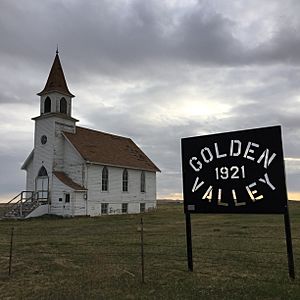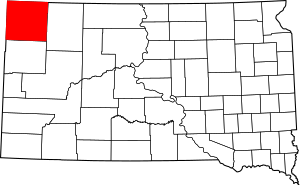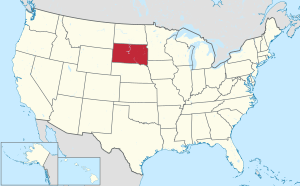Harding County, South Dakota facts for kids
Quick facts for kids
Harding County
|
|
|---|---|

|
|

Location within the U.S. state of South Dakota
|
|
 South Dakota's location within the U.S. |
|
| Country | |
| State | |
| Founded | 1881 (created) 1898 (dissolved) 1908 (re-created w revised shape) 1909 (organized) |
| Named for | J. A. Harding |
| Seat | Buffalo |
| Largest town | Buffalo |
| Area | |
| • Total | 2,678 sq mi (6,940 km2) |
| • Land | 2,671 sq mi (6,920 km2) |
| • Water | 6.5 sq mi (17 km2) 0.2% |
| Population
(2020)
|
|
| • Total | 1,311 |
| • Estimate
(2023)
|
1,324 |
| • Density | 0.48954/sq mi (0.18901/km2) |
| Time zone | UTC−7 (Mountain) |
| • Summer (DST) | UTC−6 (MDT) |
| Congressional district | At-large |
Harding County is a county in the U.S. state of South Dakota. As of the 2020 census, the population was 1,311, making it the third-least populous county in South Dakota. Its county seat is Buffalo.
Harding County was established as a county in the Dakota Territory on March 5, 1881, but was not organized at that time. Its name recognized J. A. Harding, who had been Speaker of the House of Dakota Territory. Its boundaries were altered in 1883, in 1889, and in 1894. On November 8, 1898, Harding County was dissolved and its territory assigned to Butte County. However, on November 3, 1908, it was again created (with altered boundaries) from Butte County's area, and on February 17, 1909 its governing organization was completed.
Custer National Forest has its South Dakota portion in Harding County, and South Dakota State University operates the Antelope Range and Livestock Research Station about 14 miles (23 km) east of Buffalo.
Contents
Geography
Harding County lies at the northwest corner of South Dakota. Its western boundary line abuts the east boundary line of the state of Montana, and its north boundary line abuts the south boundary line of the state of North Dakota. Its terrain consists of high hills, generally sloping to the east. Its highest point is a ridge that runs northwest to southeast near the county's southwest corner, at 3,366 ft (1,026 m) ASL.
Harding County has a total area of 2,678 square miles (6,940 km2), of which 2,671 square miles (6,920 km2) is land and 6.5 square miles (17 km2) (0.2%) is water. It is the fourth-largest county in South Dakota by area.
Major highways
Adjacent counties
- Bowman County, North Dakota - north
- Adams County, North Dakota - northeast
- Perkins County - east
- Butte County - south
- Carter County, Montana - west
- Fallon County, Montana - northwest
Protected areas
- Custer National Forest (partial)
- Gardner Lake State Game Production Area
- Mallula State Game Production Area
- State Experiment Farm and Antelope Reserve
Lakes
- Lake Gardner - it is 203 acres in surface area and is approximately 14 feet deep at its deepest point. Channel Catfish, Largemouth Bass, Walleye, Yellow Bullhead, and Yellow Perch inhabit the lake.
- Leger Dam
- Rabbit Creek Dam - this lake has a surface area of 17 acres and is inhabited by a variety of warm water fish including Largemouth Bass.
- Vessey Dam - Eight acres in size, this lake is stocked with rainbow trout.
Demographics
| Historical population | |||
|---|---|---|---|
| Census | Pop. | %± | |
| 1910 | 4,228 | — | |
| 1920 | 3,953 | −6.5% | |
| 1930 | 3,589 | −9.2% | |
| 1940 | 3,010 | −16.1% | |
| 1950 | 2,289 | −24.0% | |
| 1960 | 2,371 | 3.6% | |
| 1970 | 1,855 | −21.8% | |
| 1980 | 1,700 | −8.4% | |
| 1990 | 1,669 | −1.8% | |
| 2000 | 1,353 | −18.9% | |
| 2010 | 1,255 | −7.2% | |
| 2020 | 1,311 | 4.5% | |
| 2023 (est.) | 1,324 | 5.5% | |
| U.S. Decennial Census 1790-1960 1900-1990 1990-2000 2010-2020 |
|||
2020 census
As of the 2020 census, there were 1,311 people, 537 households, and 358 families residing in the county. The population density was 0.5 inhabitants per square mile (0.19/km2). There were 720 housing units.
2010 census
As of the 2010 census, there were 1,255 people, 539 households, and 348 families in the county. The population density was 0.5 inhabitants per square mile (0.19/km2). There were 731 housing units at an average density of 0.27 units per square mile (0.10 units/km2). The racial makeup of the county was 95.9% white, 1.5% American Indian, 0.1% black or African American, 0.1% Asian, 0.7% from other races, and 1.7% from two or more races. Those of Hispanic or Latino origin made up 1.6% of the population. In terms of ancestry, 41.4% were Norwegian, 31.8% were German, 18.4% were Irish, 13.2% were English, and 2.6% were American.
Of the 539 households, 26.0% had children under the age of 18 living with them, 55.5% were married couples living together, 4.8% had a female householder with no husband present, 35.4% were non-families, and 32.1% of all households were made up of individuals. The average household size was 2.27 and the average family size was 2.87. The median age was 43.3 years.
The median income for a household in the county was $34,792 and the median income for a family was $46,111. Males had a median income of $38,929 versus $20,924 for females. The per capita income for the county was $22,004. About 13.7% of families and 16.1% of the population were below the poverty line, including 19.5% of those under age 18 and 16.9% of those age 65 or over.
Communities
Towns
- Buffalo (county seat)
- Camp Crook
Unincorporated communities
Ghost towns
See also
 In Spanish: Condado de Harding (Dakota del Sur) para niños
In Spanish: Condado de Harding (Dakota del Sur) para niños

